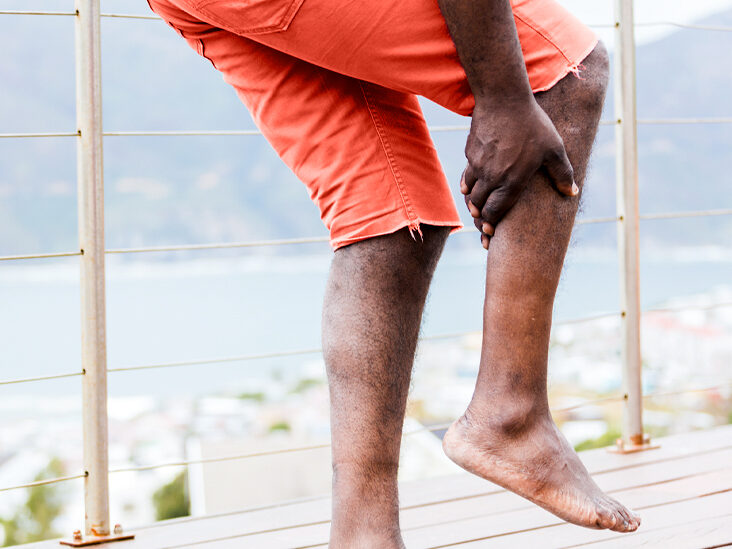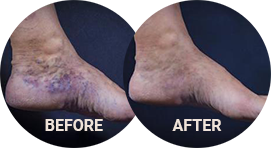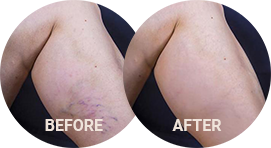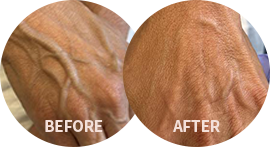Peripheral Artery Disease (PAD)
Conveniently located to serve the areas of Westlake, OH

Peripheral artery disease (PAD) is a condition that causes narrowing and clogging in the arteries of the lower limbs that restricts blood flow. The cause of PAD is usually atherosclerosis; a physical buildup of cholesterol plaques (fatty deposits) in and through the artery wall. Atherosclerosis narrows the circumference of the artery, limiting the amount of blood that can pass through at any given time. And, without treatment from a vascular specialist, the disease can cause serious health problems including mobility issues, leg cramping, and chronic infection.
Estimates put the number of people suffering from the PAD worldwide at a staggering 200 million, with more than 8 million Americans affected. (1)(2) Although it can affect younger people, the condition is of particular concern to older adults. It can begin as simple problems with leg pain, skin texture, and skin color, but can result in severe ulceration, gangrene and increased risk of heart attack and stroke.
For help with peripheral artery disease, discuss a treatment plan with the experts at Premier Vein Clinic. Board-certified vascular surgeon Dr. David Naar provides comprehensive assessment and treatment of common problems with PAD, varicose veins, venous ulcers, and spider veins. Call our Westlake, OH office at (440) 641-0433 or complete a form online to submit an inquiry.
Contents
About PAD
PAD is a circulatory problem that causes decreased lower extremity arterial perfusion; otherwise known as “poor circulation”. The buildup of fatty plaques in blood vessels cause a narrowing that restricts blood flow and causes pain in the legs. (1) Although it exists as a standalone condition, research indicates that PAD is more common in patients with certain venous conditions.
PAD Fact: Patients with severe forms of chronic venous insufficiency (CVI), which causes varicose veins and venous ulcers, more frequently develop symptoms of PAD. (3)
Although many people with PAD don’t realize they have it, and do not show any physical symptoms,there are a number of visual clues in the legs that indicate the condition.
Common Symptoms of PAD
- Pain in leg muscles
- Discomfort when walking
- Fatigue and weakness in the legs
- Leg cramping and numbness
- Non healing wounds
- Muscle atrophy
- Legs painful to the touch
- Cool, bluish-purple skin
- Audible sound of blood flow (bruit)
- Hair loss
- Erectile dysfunction (1)
What is Ischemic Rest Pain?
Ischemic rest pain (IRP) is another symptom which can cause significant disruptions in the lives of people with peripheral artery disease. Described as a burning pain in the ball of the foot, IRP occurs when insufficient blood flow reaches the extremities, even at rest.
PAD Fact: Many people with PAD do not realize they have it. They put the pain in their legs when they walk down to the natural progression of aging alone. To rule out PAD, and to get your health back on track, seek an expert opinion to ensure you can live your life to the fullest.
Am I at Risk for PAD?
There are several risk factors for developing PAD, which include the following.
- Being over the age of 50
- Diabetes mellitus
- Being a smoker
- Excess weight (BMI 30 or above)
- High blood pressure (hypertension)
- High cholesterol (hyperlipidemia)
- Family history of PAD, heart disease, or stroke (1)
What Are Homocysteines and Why Do They Matter?
Homocysteines are proteins (amino acids) that have been linked to the development of peripheral artery disease. Higher homocysteine levels in the body may signify a nutritional deficiency and a lack of vitamins B12 and folic acid, which may lead to feelings of fatigue, dizziness, pale skin, and mouth sores. A recent meta-analysis confirms that patients with PAD have homocysteinemia; significantly higher levels of homocysteines, compared with people who do not have the condition. (4)
Personal Consultation
Leg pain can be a concern for men and women of any age. If you suspect you have symptoms of PAD, particularly if you are over 50, and if it is negatively affecting your quality of life, arrange a personal consultation with Dr. Naar at Premier Vein Clinic. We will ask you to provide some details about your medical history, and your current health. This is an opportunity for you to provide further information about any comorbid conditions you have such as diabetes and high blood pressure. Dr. Naar will perform a thorough physical examination and ask you questions about the difficulties you have faced. He will then perform further diagnostic testing for PAD.
How Do Doctors Test for PAD?
- Assessment of walking ability
- Ankle Brachial Index Test (ABIT)
- Evaluation of risk factors (family history, comorbid diseases)
- Testing for chronic venous insufficiency
- Cardiologist report (where indicated)
Find out more about treatments for vascular issues by reading the Premier Vein Clinic blog.
What is the ABI?
The ankle brachial index (ABI) is a simple way to measure blood pressure in the upper and lower limbs. It compares the data between the two measurements. This accurately indicates the presence of arterial narrowing which signifies PAD. An assessment of function is conducted in the following way.
Measuring Brachial Pressures
In the examination room, Dr. Naar begins by taking blood pressure measurements in your arms (brachial) with a standard blood pressure cuff while you are lying down. He measures blood flow in the brachial arteries by pumping up and releasing pressure in the cuff to find your systolic blood pressure, as would happen at a standard physical.
While he takes your blood pressure reading, Dr. Naar uses a Doppler ultrasound device to amplify the sound of arterial blood flow. When the cuff is inflated, there is no ultrasound signal, however, when it is deflated, the ultrasound signal is audible again. He records these results before moving on to the readings at the ankle.
Measuring Ankle Pressures
Following the brachial reading, Dr. Naar repeats the process at the ankles. He takes the pulse at the dorsalis pedis; the artery found on the upper foot. Using the same technique as the brachial measurement, Dr. Naar inflates the cuff, then releases pressure while measuring the ultrasound readings. He also uses the posterior tibial artery (immediately behind the prominence of the ankle) to take further readings.
Calculating ABI
To calculate the ankle-brachial index, Dr. Naar divides the two pressures at the ankle by the brachial systolic pressure. The sum of these variables is the ABI. Normal ABI readings are between 1.0-1.4, with higher readings indicating arterial hardening, and lower readings below 0.9 indicative of PAD. (5)
Managing Peripheral Artery Disease
Smoking Cessation
Prior to more advanced treatment, or as part of a comprehensive treatment plan, patients who smoke are advised to stop smoking. If quitting smoking is challenging, behavioral therapy, nicotine replacement therapy, or pharmacological therapy may be advised. (6)
Medical Management
Dr. Naar may recommend one or a combination of medications to treat PAD. These include:
- Aspirin
- Clopidogrel
- Antiplatelet Medications
- Antihypertensive Medications
- Statins (Cholesterol-Lowering Drugs)
- Angiotensin Converting Enzyme Inhibitors
- Angiotensin Receptor Blockers
- Diabetic Medications
- Vasodilators (6)
Supervised Exercise
Supervised exercise therapy (SET) is beneficial for many people with PAD who find walking difficult. Supervised walking therapy can be a viable treatment before surgical intervention takes place, improving mobility and overall quality of life.
Wound Care
Maintaining healthy feet and caring for foot ulcers is important for mobility and overall health for people with PAD. It is crucial to seek treatment for wounds caused by PAD to avoid serious complications, which include limb gangrene and the possible risk of limb amputation. (6)
Revascularization Surgery
Endovascular revascularization is a medical procedure that can restore blood flow in blocked blood vessels. Whether surgical measures are warranted or not is assessed on a case by case basis. Dr. Naar maps the route of the targeted leg artery and anesthetizes it. A guidewire is inserted into the artery and a dilation balloon device is placed inside the stricture. Atherectomy uses a laser fiber delivering pulses of laser energy to open the artery and reduce the blockage. It is recommended for people with cramping (disabling claudication) caused by PAD, but is not indicated for asymptomatic patients. (6)
Cost of Peripheral Artery Disease Treatment in Westlake, OH
For treatment options for peripheral artery disease, please get in touch with Premier Vein Clinic. Booking a personal consultation with Dr. Naar will give you the opportunity to speak with an expert vascular surgeon about your condition so you can move forward with an individualized treatment plan. Please call (440) 641-0433 or contact us via our online inquiry form for further information.
Join Dr. Naar on Facebook!
References
- Zemaitis MR, Boll JM, Dreyer MA. Peripheral Arterial Disease. Nih.gov. Published June 28, 2019. https://www.ncbi.nlm.nih.gov/books/NBK430745/
- Virani SS, Alonso A, Benjamin EJ, et al. Heart Disease and Stroke statistics—2020 Update. Circulation. 2020;141(9). doi:10.1161/cir.0000000000000757https://www.ahajournals.org/doi/epub/10.1161/CIR.0000000000000757
- Matic M, Matic A, Djuran V, Gajinov Z, Prcic S, Golusin Z. Frequency of Peripheral Arterial Disease in Patients With Chronic Venous Insufficiency. Iranian Red Crescent Medical Journal. 2016;18(1). doi:10.5812/ircmj.20781 https://www.ncbi.nlm.nih.gov/pmc/articles/PMC4752728/
- Khandanpour N, Loke YK, Meyer FJ, Jennings B, Armon MP. Homocysteine and Peripheral Arterial Disease: Systematic Review and Meta-analysis. European Journal of Vascular and Endovascular Surgery. 2009;38(3):316-322. doi:10.1016/j.ejvs.2009.05.007 https://www.ejves.com/article/S1078-5884(09)00248-2/fulltext
- Ankle Brachial Index. Stanford Medicine 25. https://stanfordmedicine25.stanford.edu/the25/ankle-brachial-index.html
- Gul F, Janzer SF. Peripheral Vascular Disease. PubMed. Published 2020. https://www.ncbi.nlm.nih.gov/books/NBK557482/




